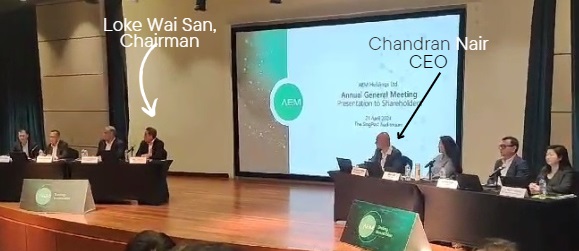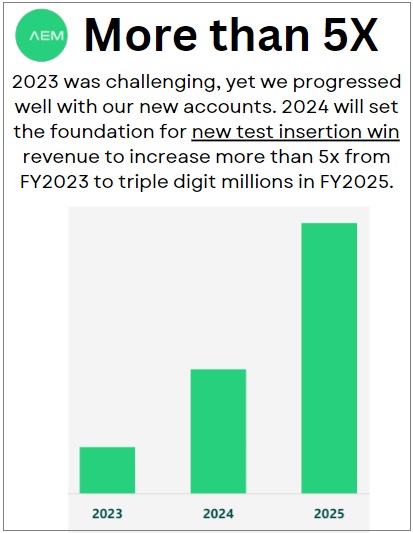| "It is clear that we are at an inflection point in the history of humanity. On our current trajectory, we're headed towards the emergence of something that we are all struggling to describe ..." -- CEO, Microsoft AI, Mustafa Suleyman, on Artificial Intelligence 5G, Internet of Things. And the new kid on the block -- AI. The breathtaking speed of the emergence of such groundbreaking technologies presents AEM Holdings with new business opportunities and strategic importance to customers. AEM says it has the right stuff for back-end testing of semiconductor chips which have been increasing in complexity, especially AI chips.  Poised for exciting times ahead, AEM held its AGM on 24 April at SingPost Auditorium. Below are some takeaways from a Q&A session which saw several shareholders pose interesting questions to the management: |
1. New customer: A week ago, AEM Holdings announced a new customer win. It's "two program wins within one customer" -- meaning, two distinct initiatives or product lines within that customer's operations.
The unnamed customer is a "major fabless provider of high-performance compute (HPC) and artificial intelligence (AI) semiconductor chips."
AEM's non-executive chairman Loke Wai San said at the AGM: "That took us four years. And obviously, this customer being in the top five in the world is not a small customer. They have existing supplier relationships that lasted decades. So for us to displace an existing supplier is very, very difficult. It's a very serious decision that goes all the way to the C-suite. So we think this is very significant."
Somewhere further along the AGM, to further convey the quality of AEM's product, he added: "Those of you who introduce new products know that it's not good enough to be 30% better. You have to be 2x better, 3x better, before they even make that switch. It's a lot of retraining of the engineers, re-laying out the test goals."
2. Potential new customers: Nope, the above-mentioned new customer is not connected to AEM's current and long-established key customer (which is officially not identified but everyone knows it is ... Intel).
In fact, there are 5 potential customers that AEM is having engagements with currently -- and they are all not connected to Intel. In other words, AEM is expanding its customer base independently but ... it also is in a position to expand via Intel.
Intel has an emerging foundry business -- ie it manufactures chips.
AEM's back-end testing equipment is potentially going to be attractive to any new customer of Intel's foundry business. Thus, it's possible that some future customers of AEM will come through this route. Stay tuned.
 Text & graph: AEM PowerPoint deck Text & graph: AEM PowerPoint deckEssentially, "insertion wins" means AEM's equipment is being designed into and "inserted" into the customer's testing process flow. • In 2023, AEM won key evaluation projects with large semiconductor companies (fabless companies that design but don't manufacture chips) to evaluate AEM's test solutions. • AEM expects these successful evaluations will lead to those customers selecting AEM's test equipment for use in production testing of their chips starting in 2024. • AEM then anticipates these new customer wins will further grow and scale up in 2025 as the customers ramp up production volumes of their new chip designs. |
3. Testing demands: While the goal of a manufacturer is always to reduce test times in order to save costs, as new chip generations are introduced rapidly, it is quite difficult to test less if you want reliability.
As chips become more complex, with more transistors and features like high bandwidth memory, the need for testing actually increases.
(High Bandwith Memory is a type of memory architecture that is particularly beneficial for applications that require large amounts of data to be moved quickly, such as graphics processing, high-performance computing, networking, and more recently, AI and machine learning).
Where testing can be reduced is for mature nodes as the processes are well-understood and have been optimized over time.
It's just like software. When new, there may be many bugs. The more mature the software is, the less bugs there are.
4. Arbitration: In July 2023, AEM announced the settlement of an arbitration, saying "The Settlement is final and was reached without any findings or admissions as to breach or liability."
While AEM affirmed its view that the suit by Advantest was without merit, shareholders learnt that AEM settled (at a loss of US$20 million) because:
| • Its legal costs were mounting in the millions -- about S$15 million a year -- and it weighed that against the possible settlement amount. • The suit was impeding progress with a new customer who was concerned about intellectual property issues. |
AEM saw the settlement as a necessary step to move forward and secure the new customer mentioned above.
And it did: "The new customer chose us for a very meaningful transformational program. And I think you can rest assured they did all their IP due diligence," said Mr Loke.
Additionally, AEM has taken steps to "strengthen our patent portfolio tremendously" to protect against such legal challenges in the future, which are not uncommon in the global semiconductor industry.
The PowerPoint deck used in the AGM is here.







